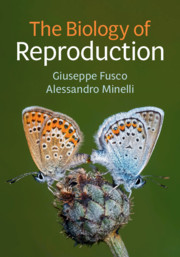Book contents
- The Biology of Reproduction
- The Biology of Reproduction
- Copyright page
- Contents
- Preface
- Figure Credits
- Introduction
- Chapter 1: Introductory Concepts
- Chapter 2: Reproduction and Life Cycle
- Chapter 3: The Natural History of Reproduction
- Chapter 4: Parental Investment in Sexual Reproduction
- Chapter 5: Genetics and Cytogenetics of Reproduction
- Chapter 6: Determination of Sex and Mating Type
- Chapter 7: Reproduction: a Taxonomic Survey
- Coda
- Appendix: A Classification of Living Organisms
- References
- Taxonomic Index
- Subject Index
Chapter 3: - The Natural History of Reproduction
Published online by Cambridge University Press: 30 September 2019
- The Biology of Reproduction
- The Biology of Reproduction
- Copyright page
- Contents
- Preface
- Figure Credits
- Introduction
- Chapter 1: Introductory Concepts
- Chapter 2: Reproduction and Life Cycle
- Chapter 3: The Natural History of Reproduction
- Chapter 4: Parental Investment in Sexual Reproduction
- Chapter 5: Genetics and Cytogenetics of Reproduction
- Chapter 6: Determination of Sex and Mating Type
- Chapter 7: Reproduction: a Taxonomic Survey
- Coda
- Appendix: A Classification of Living Organisms
- References
- Taxonomic Index
- Subject Index
Summary
Chapter 3 covers the natural history of reproduction. A first section on asexual reproduction deals with the different forms of cell division in unicellular prokaryotes and eukaryotes. A short interlude introduces the notion of sex and describes sexuality phenomena uncoupled from reproductive processes, both in prokaryotes and in unicellular eukaryotes. The main types of sexual reproduction (gametogamy, gamontogamy, autogamy) are described, as are the distinction between sexes and mating types and the different ways in which sexual roles can be distributed within the population. Short paragraphs are devoted to secondary sex characters and to conditions such as aneuploidy, gynandromorphism and intersexuality. Attention is then shifted to the reproductive organs of the metazoans and the morphology of eggs and spermatozoa, and also to the reproductive organs of the plants and the morphology of their gametes. Finally, the fate of gametes is described, both in typical biparental reproduction, with particular regard to its ecological context, and in uniparental sexual reproduction (self-fertilization, parthenogenesis, gynogenesis, androgenesis and hybridogenesis).
Keywords
- Type
- Chapter
- Information
- The Biology of Reproduction , pp. 86 - 195Publisher: Cambridge University PressPrint publication year: 2019



